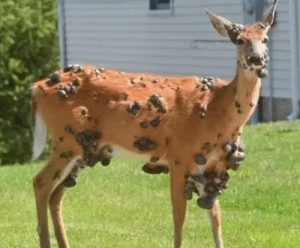After squirrels and rabbits were spotted with strange growths, now deer across New York, Pennsylvania, and Wisconsin have been photographed with similar lumps—sparking fears of a new outbreak.
Wildlife officials say the cause isn’t new at all. The growths, known as deer cutaneous fibroma or “deer warts,” are caused by a virus spread mostly through mosquitoes and ticks. Though the condition looks alarming, it isn’t painful for the animals. The warts often dry up and fall off within a few months, though they can sometimes interfere with eating, walking, or seeing.
The virus belongs to the same family as human papillomaviruses, but it can’t spread to people. What does pose a risk, however, are the ticks that deer carry—since they can transmit illnesses like Lyme disease. Doctors warn that shifting temperatures are expanding the range of such diseases into new areas, including parts of Canada and northern U.S. states.

While social media has recently drawn attention to the issue, experts say deer warts have been in the U.S. since at least the 1950s. For most deer, the condition clears up naturally, even if it looks unsettling at first glance.





